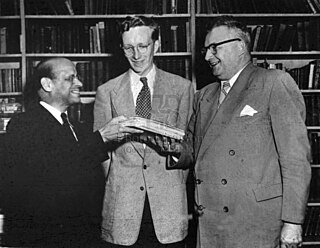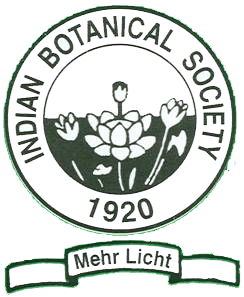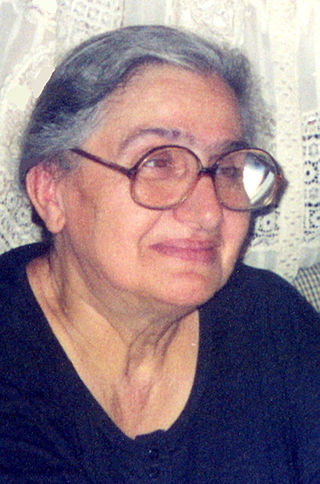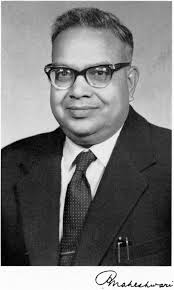
Birbal Sahni FRS was an Indian paleobotanist who studied the fossils of the Indian subcontinent. He also took an interest in geology and archaeology. He founded what is now the Birbal Sahni Institute of Palaeobotany at Lucknow in 1946. His major contributions were in the study of the fossil plants of India and in plant evolution. He was also involved in the establishment of Indian science education and served as the President of the National Academy of Sciences, India and as an Honorary President of the International Botanical Congress, Stockholm.

Bengaluru Gundappa Lakshminarayana Swamy was an Indian botanist and Kannada writer who was professor, head of the botany department and principal of Presidency College, Chennai. He was the son of D. V. Gundappa, an Indian philosopher and writer in the Kannada language.

Kailas Nath Kaul (1905–1983) was an Indian botanist, naturalist, agricultural scientist, horticulturist, herbalist, plant collector and herpetologist, and a world authority on Arecaceae. He founded India's National Botanical Research Institute and was instrumental in organizing the country's modern scientific infrastructure. He is regarded as a vital influence behind his niece Indira Gandhi's proactive role in environmental protection by means of extensive legislative and policy interventions.
Kartar Singh Thind was a botanist. He was born in Saidpur, Sultanpur Lodhi tehsil, Kapurthala district, Punjab, India.

The Indian Botanical Society (IBS) is the national learned society for botanists of India. It was founded in 1920.

Guranda Gvaladze was a notable Georgian botanist, one of the founders of Plant Embryology in Georgia, Academician of the Abkhazian Regional Academy of Sciences (1997), Doctor of Biological Sciences (1974), Professor (1991). Her father Evgen Gvaladze (1900-1937) was a notable Lawyer and Publicist, one of the leaders of the National-Liberation Movement of Georgia of 1921–1937.
Shankar Purushottam Agharkar was an Indian Morphologist. Agharkar obtained his PhD degree (1919) from the University of Berlin, Germany. His specialization was in Plant Morphology. He was the Ghosh Professor of Botany (1920–47) at the University of Calcutta; and Founder Director (1946–60) of Maharashtra Association for the Cultivation of Science. He is one of the leading botanists of India. He explored biodiversity of Western Ghats where he came across a species of freshwater jellyfish, which was until then only known to be found in Africa. These findings were published in scientific journal Nature in 1912. Dr. Annandale, the Superintendent of the Indian Museum in Kolkata, helped Dr. Agharkar in his further endeavours to collect, preserve and conduct microscopic examinations of animal and plant specimens. The institute ARI, Pune has been named after him.
Hermenegild Santapau (1903-1970) was a Spanish born naturalized Indian Jesuit priest and botanist, known for his taxonomical research on Indian flora. He was credited with the Latin nomenclature of several Indian plant species. A recipient of the Order of Alphonsus X the Wise and the Birbal Sahni Medal, he was honoured by the Government of India in 1967, with the award of Padma Shri, the fourth highest Indian civilian award for his contributions to the society.
Gopinath Panigrahi is a botanist and plant taxonomist. He was born in the village Baikunthapur, Basudebpur block, Bhadrak district, Orissa, India and obtained a Ph.D. in 1954 from the University of Leeds where he studied Cytogenetics.
Gopalasamudram Sitaraman Venkataraman (1930–1998) was an Indian botanist, academic and the director of the Indian Agricultural Research Institute (IARI), New Delhi. He was also a director of the DBT Centre for Blue-Green Algae at Madurai Kamaraj University and a recipient of the VASVIK Industrial Research Award and Om Prakash Bhasin Award. The Government of India awarded him the fourth highest civilian honour of the Padma Shri in 1992.
Sudhir Kumar Sopory is an Indian educationist, plant physiologist, scientist and former vice chancellor of Jawaharlal Nehru University, New Delhi. He is known to be the first to purify a protein kinase C activity from plants and is credited with the identification of topoisomerase as a substrate of protein kinase C. He is an elected Fellow of several major Indian science academies and The World Academy of Sciences (TWAS) and is a recipient of many honours, including the 1987 Shanti Swarup Bhatangar Prize, the highest Indian award in the science and technology categories. The Government of India awarded him the fourth highest civilian honour of the Padma Shri, in 2007, for his contributions to science and technology.
Toppur Seethapathy Sadasivan was an Indian plant pathologist, academic and the director of the Centre for Advanced Studies in Botany of the University of Madras. He was the founder of the School of Physiological Plant Pathology at Madras University and was a recipient of the Shanti Swarup Bhatnagar Prize, the highest Indian award in the science category. He was an elected fellow of the Indian Academy of Sciences, Indian National Science Academy and Indian Botanical Society and an elected member of the Academy of Sciences Leopoldina. The Government of India awarded him the third highest civilian honour of the Padma Bhushan, in 1974, for his contributions to science.
Chirayathumadom Venkatachalier Subramanian, popularly known as CVS, was an Indian mycologist, taxonomist and plant pathologist, known for his work on the classification of Fungi imperfecti, a group of fungi classified separately due to lack of specific taxonomic characteristics. He authored one monograph, Hyphomycetes: An Account of Indian Species, Except Cercosporae and three books, Hyphomycetes, taxonomy and biology, Moulds, Mushrooms and Men and Soil microfungi of Israel, besides several articles published in peer-reviewed journals. He was a recipient of many honours including the Rafi Ahmed Kidwai Award of the Indian Council of Agricultural Research, the Janaki Ammal National Award of the Government of India and seven species of fungi have been named after him. The Council of Scientific and Industrial Research, the apex agency of the Government of India for scientific research, awarded him the Shanti Swarup Bhatnagar Prize for Science and Technology, one of the highest Indian science awards, in 1965, for his contributions to biological sciences.

Arun Kumar Sharma, popularly known as AKS, was an Indian cytogeneticist, cell biologist, cytochemist and a former Sir Rashbehary Ghose Professor and Head of the Department of Botany at the University of Kolkata, College of Science and Technology. Considered by many as the father of Indian cytology, he headed the Centre for Advanced Study on Cell and Chromosome at the university and is known for his contributions to the studies on the physical and chemical nature of chromosomes. A Jawaharlal Nehru fellow, he is a recipient of several honors including the Om Prakash Bhasin Award and the VASVIK Industrial Research Award. The Council of Scientific and Industrial Research, the apex agency of the Government of India for scientific research, awarded him the Shanti Swarup Bhatnagar Prize for Science and Technology, one of the highest Indian science awards, in 1967, for his contributions to biological sciences. The Government of India awarded him the third highest civilian honor of the Padma Bhushan in 1983.
Satish Chandra Maheshwari was an Indian botanist and a former professor at the University of Delhi. He is known for his contributions to the fields of plant physiology and plant molecular biology. Maheshwari is an elected fellow of the Indian Academy of Sciences, the Indian National Science Academy and the National Academy of Sciences, India. The Council of Scientific and Industrial Research, the apex agency of the Government of India for scientific research, awarded him the Shanti Swarup Bhatnagar Prize for Science and Technology, one of the highest Indian science awards, in 1972, for his contributions to biological sciences. He died from lung cancer on June 12, 2019.
Holenarasipur Yoganarasimham Mohan Ram was an Indian botanist who influenced numerous students as a professor of Botany at Delhi University. His research areas included studies in floral biology, plant physiology, insectivorous plants and on the family Podostemaceae. He was a brother of H. Y. Sharada Prasad and the father of Indian Ocean's Rahul Ram.

Shiv Ram Kashyap was a botanist in British India. He was a specialist on the bryophytes especially from the Himalayan region. He has been called the father of Indian bryology.

Savitri Sahni, born Savitri Suri, was president of the Birbal Sahni Institute of Paleosciences from 1949 to 1969.

Mamiyil Sabu formerly Head of the Department of Botany, University of Calicut and currently working as CSIR-Emeritus Scientist at Malabar Botanical Garden and Institute for Plant Sciences, Kozhikode district, Kerala, India. He worked for over 37 years on the research of gingers, which include families such as Cannaceae, Marantaceae, Zingiberaceae, Heliconiaceae, Costaceae, Musaceae etc. A comprehensive work on these groups have been taken after a gap of 125 years, which resulted in the discovery of several new species and rediscovery of many species after 155 years.
Rajendra Nath Lakhanpal was an Indian paleobotanist. He was a specialist on palaeo-ecology and the identification of plants from pollen microfossils.









